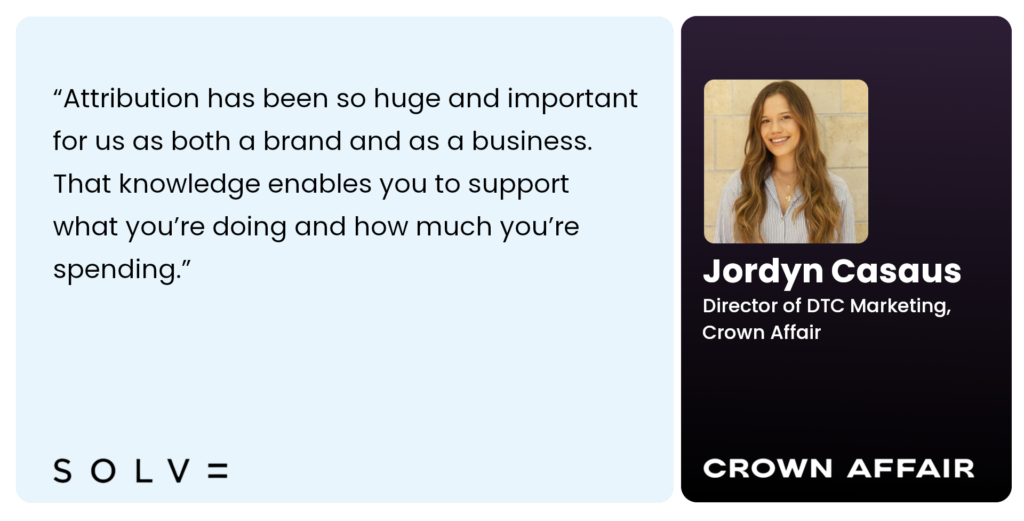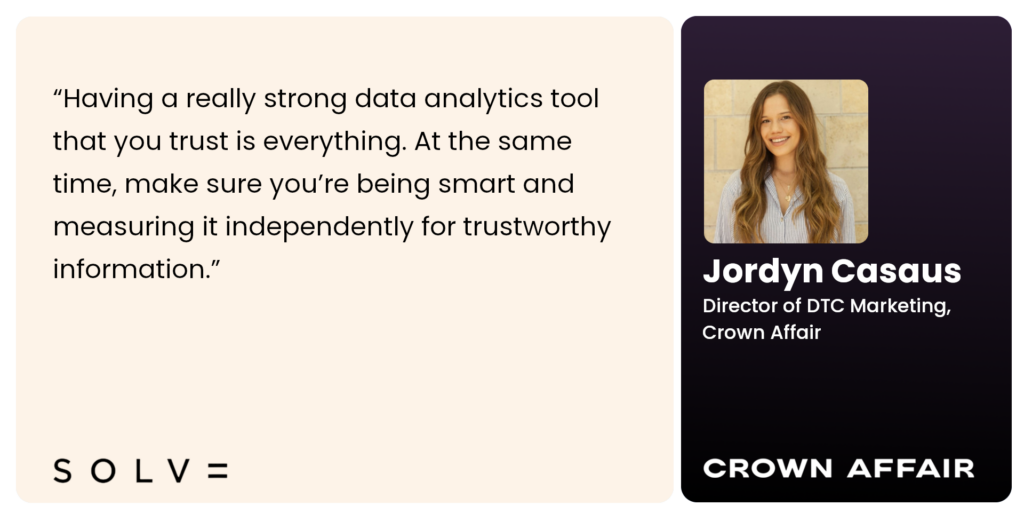There’s no doubt that eCommerce data is essential for informed decision-making as a brand.
However, the importance of attribution in that marketing equation is often overlooked.
That’s why the Solve team sat down with Jordyn Casaus, Director of DTC Marketing at Crown Affair. In under three years, the innovative hair care brand has scaled to 15+ full-time employees, a loyal digital customer base, and a successful partnership with Sephora — thanks in part to a high-ROI marketing strategy.
Across her entire DTC marketing playbook, Jordyn highlights attribution as a crucial step. So, she walked us through her attribution tactics below. We’ll unpack topics such as:
- Why exactly attribution is so essential for marketers
- Her fundamental steps for setting up your brand’s attribution
- Why she recommends Solve’s data dashboard above all for attribution
Let’s dive in.

This is why DTC marketers should be stressing attribution
Attribution isn’t vital to marketers alone. It can indicate whether your company as a whole is operating from a healthy place.
In Jordyn’s experience, a strong indicator of a healthy brand is seeing a majority of traffic, top-line sales, and revenue coming from the organic side of the spectrum. This looks like pure word of mouth and potential customers wanting to discover your company.
For instance, Crown Affair launched their brick-and-mortar partnership with Sephora in the last year. Jordyn made sure to closely monitor attribution throughout.
- When shoppers walked into Sephora and noticed Crown Affair products, she predicted they’d Google the brand from there — leading to an increase in overall traffic and direct website sales.
- If they’d launched in Sephora and seen little-to-no uptick in revenue (compared to paid channels), she would have worried about what that meant for their organic methods.
Ultimately, with the proper attribution systems in place, your team receives signals on what’s working, what’s worth your cash, and what next steps should be to meet your revenue goals.
“At a high level, the biggest attribution advice I’d give to DTC marketers is to ensure everything is set up and looked at correctly. Plus, a strong tech stack can only help on those fronts.”
3 steps to setting up your brand’s attribution
For DTC brands looking to get their attribution in order, Jordyn recommends starting with the following three steps:
1. Nail the fundamentals
It may sound simple but it’s critical to ensure you set everything up properly. That means:
- Ensuring your UTM parameters are configured correctly
- Ensuring metrics such as views, sessions, revenue, etc. are defined on the back end
- Ensuring you’re properly integrated with every platform you’ll be selling on and streaming data from
2. Define the attribution windows of your various channels
Jordyn emphasizes that this is a valuable step which, when overlooked, can cause confusion down the line.
If you’re selling on or marketing through certain channels, make sure you understand how their attribution windows function.
For instance, Attentive vs. Klaviyo serve different communication mediums — and may also pull, process, and stream attribution numbers differently.
3. Balance a manual approach with reliable data tooling
It may be an unpopular opinion, but Jordyn notes that she’s never trusted Google Analytics entirely. Instead, she recommends this reliable combination:
Measure in-platform, pull everything manually, and then circle back to data platforms like Google Analytics as a final layer.
Simultaneously, Jordyn reminds us there is a reasonable balance between cautious manual input and having a platform you trust. For Crown Affair, that trusted platform is Solve.
In addition, Jordyn advises that attribution ties into the big picture of your brand’s marketing — not just the digital end. Whether it’s PR and referrals or activation events, how is all of that data streaming in and being accounted for on the attribution side?

Why Jordyn champions Solve for every DTC marketer
Jordyn puts it simply: “Attribution models are so difficult to explain,” especially when your finance or business teammates may oversimplify the meaning of the numbers. “It’s the pain of every marketer’s existence.”
This is only exacerbated if you’re relying on the wrong tools or platforms. For instance:
- With Google Analytics, a last-click attribution model means, “you get a million questions on what everything means and why.” Unfortunately, you may have to fire back with, “Take this with a grain of salt — it’s real but not at the same time.”
- With Klaviyo, its five-day attribution model means your brand may look like it’s making far more money than it actually is.
- With Shopify, you’ll explain how the platform pulls from certain channels but not others.
- Finally, Jordyn has given up entirely on measuring in-platform ROAS with Meta.
Compared to these past experiences, Jordyn calls Solve a game-changer for attribution. With the way Solve’s scripts and models are configured, the Crown Affair team can trust how accurate and reliable the resulting data is.
As a result, Solve is far more accessible (not just to marketing teams) and frees up Jordyn’s time from extensive reporting and explanations.
“When it comes to attribution, working in Solve specifically is just so helpful and a lot easier for me. It requires far less explanation to the rest of my team. If I didn’t have Solve, I would have to juggle so many more issues.”
Previous Next